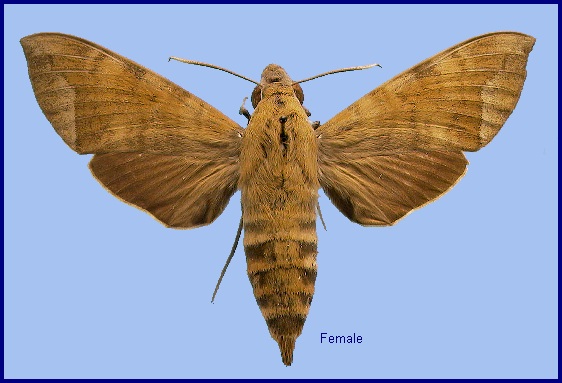
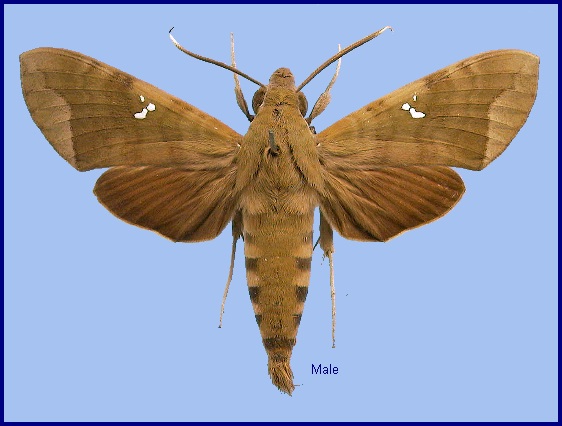
Sphinx hespera Fabricius, 1775, Syst. Ent.: 546. Type locality: "India orientali".
Synonym. Sphinx hespera Fabricius, 1775.
Synonym. Sphinx didyma Fabricius, 1775, Syst. Ent.: 543. Type locality: "India orientali".
Synonym. Sphinx chiron Cramer, 1777.
Synonym. Sphinx morpheus Cramer, 1777.
Synonym. Sphinx quaterna Esper, 1794.
Synonym. Perigonia obliterans Walker, 1865.
Wingspan: 70--86mm. Variable. Forewing upperside usually with two silver spots, one minute dot, or without any such spots at all in both sexes. Forewing underside with postmedian and submarginal lines parallel. Hindwing dark yellowish-brown or reddish-brown; marginal area darker in tint. Abdomen upperside with lateral black patches on segments 3 to 7. Differs from nearly all other species of Nephele in the apical hindtibial spurs having only a few, rather thin, distally situated spines. Hindbasitarsal comb less developed than in African species of Nephele.
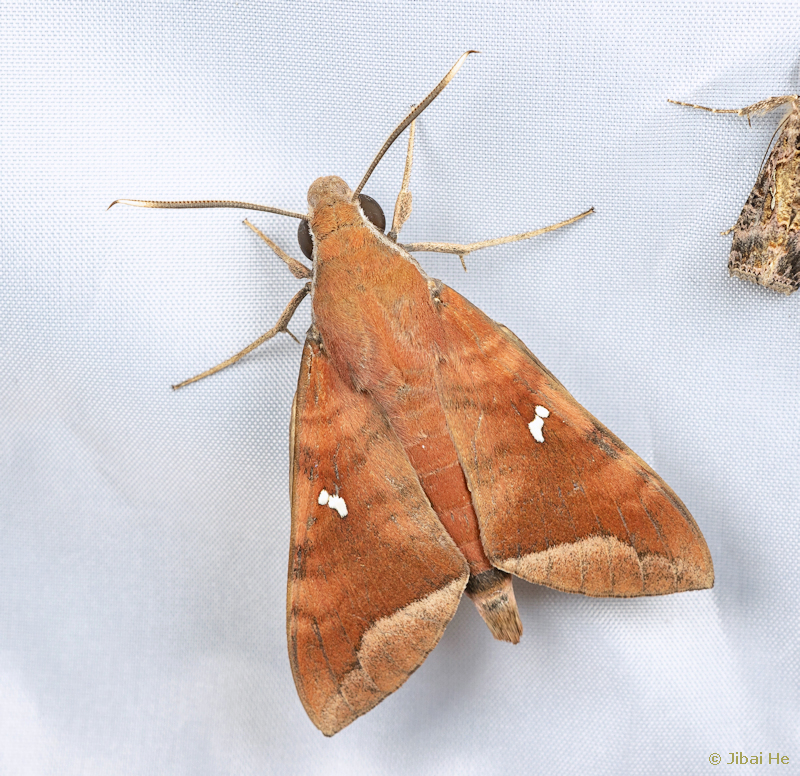
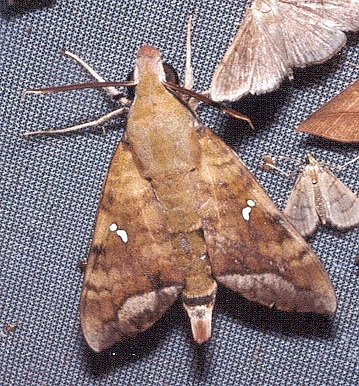
The moth rests with the wings held horizontal and the tip of the abdomen slightly upturned. The flight is rapid, with the moth coming to flowers before dark; also attracted to light (Bell & Scott, 1937).
China: 14.iii (Yunnan); vi (Yunnan); viii (Yunnan); 19.x-xi (Hong Kong); 10.xi (Yunnan); 7.xii (Macau).
Kendrick (2002) states that this species may only be a vagrant or rare migrant to Hong Kong.
OVUM: Pale green, slightly oval (1.4 x 1.6mm), shiny and smooth. Laid singly on the underside of a leaf or on a thorn of the hostplant (Bell & Scott, 1937).
LARVA: Full-fed 70mm. Dichromatic: green or brown. According to Bell & Scott (1937), head rounded-quadrate; true clypeus less than half length of head, apex acute, basal angles slightly rounded; false clypeus forming a wide arch over apex of true clypeus, reaching to one-half length of head; labrum more than one-third length of clypeus, the sides curving inwards; ligula longer than labrum, the lobes very broadly rounded, the sinus small, rounded-triangular; eyes with 1, 2, 3 and 4 equidistant in a slight curve, 6 in line with 3 and 4, and 5 forming an equilateral triangle with 4 and 6. Surface of head dull and smooth. Body tapering somewhat sharply from segments 5 to 2, rest of body nearly cylindrical; surface dull and smooth. Horn rising from a conical tumidity; long, stout, tapering evenly to a blunt tip, from the dorsal surface of which projects a short conical tooth; basal half of horn slightly down-curved, distal half straight.
In the green form, head grass-green; labrum green; ligula dull violet; basal segment of antenna pale green, other segments blood-red; mandible yellow, tip dark reddish-brown; eyes brown. Body green, dotted closely with yellow; a narrow violet dorsal stripe, touched with black at the front. margins of segments 6 to 11; a pale yellow dorso-lateral stripe, starting at the middle of the hind margin of 7 and running to base of horn; broad, white, and sharply defined on 12, edged narrowly above by dark green or violet; very obscure yellowish-green oblique stripes on 4 and 5; a broad, white, sharply defined oblique stripe, finely veined with dark lilac, on 6, running back on to 7; a pure white oblique stripe on 11 and 12 meeting the dorso-lateral stripe at a sharp angle on 12, the angle between the two stripes filled in with white. Horn dark fuscous-violet, the conical point chestnut; legs white with a dark brown streak down the outer face of each segment; prolegs with base and shank green, ankle green tinged with violet, feet violet. Spiracles small, flush, brown with a dusky band across the middle and with a narrow, yellow rim. The dorsum turns brown before pupation. In the dark form the green ground-colour is replaced by brown, with markings as in the green form (Bell & Scott, 1937).
At rest the larva raises the head and anterior segments at a sharp angle with the rest of the body.
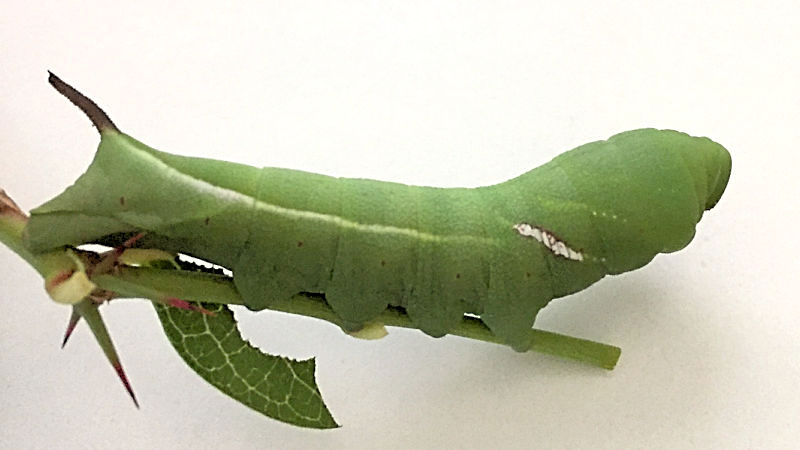
PUPA: 66mm. Colour bone-yellow, tongue-sheath pinkish, abdomen suffused with pale violet-brown; a dark brown dorsal stripe on thorax becoming broad and greenish on abdomen; venter pale pinkish-yellow, with a brown interrupted central stripe; spiracles and cremaster black. Slender in build; tongue-sheath projecting much frontad, the ventral surface of sheath concave basad; antenna about half length of wing-case, foreleg slightly shorter; a narrow coxal piece. Surface dull, superficially, transversely wrinkled on head, thorax and wing-case, sparsely pitted on abdomen; short, irregular ante-spiracular ridges on segment 9. Spiracle of 2 a narrow slit nearly covered by a narrow, oblong, transverse lobe projecting from the front margin of 3; remaining spiracles broadly oval, surface slightly convex, central slit with raised edges. Cremaster nearly oblong, with a small, conical tooth, directed outwards, at each lateral angle of the truncate tip; dorsal surface convex and pitted; ventral surface with a deep median channel. Formed in a rough cocoon on the surface of the ground (Bell & Scott, 1937).
Larval hostplants. Carissa carandas (Apocynaceae) in India (Bell & Scott, 1937), a plant used in Indian cooking.
China: Hubei (Lichuan); Sichuan (Xiushan); Yunnan (Mengzi; Laojun Shan, 2579m; nr. Yingjiang, Xima, 2080m; Simao/Pu'er; Gaoligong Shan; Liuku/Lushui, Nujiang Lisu Autonomous Prefecture; Honghe Hani and Yi Autonomous Prefecture); south Xizang/Tibet (Mutu, Namjagbarwa region, 850m; Zhangmu, 2200m; Yi'ong, 2700m; Nyalam, 2250m); Hong Kong (Lantau Island); Macau.
From Afghanistan and Pakistan (Rafi et al., 2014; Haxaire, Gujjar & Saeed, 2017) south and east across Sri Lanka, India (Chandra, Pandey, Bhandari & Sambath, 2013; Pathania, Sunita Sharma & Gill, 2014; Chakraborty, Chakraborty, Biswas, Chakraborty & Deb, 2024), Nepal, Sikkim (Khan & Raina, 2017), Bhutan (Irungbam & Irungbam, 2019), the Andaman Islands, Myanmar/Burma, Thailand, Laos and Vietnam (Le & Vu, 2024), to southern China, Peninsular Malaysia and Sumatra. It has also been recorded from southern Papua New Guinea and the Dauan and Warraber Islands off the northern tip of Queensland, Australia.
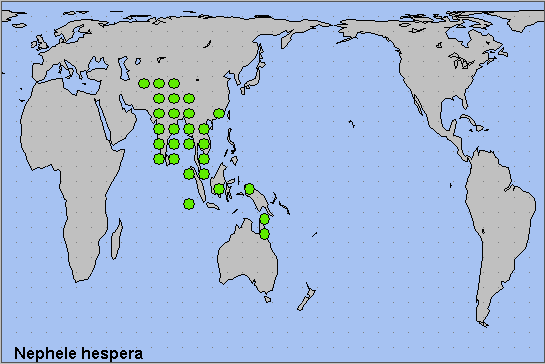
 Return to Sphingidae of the Eastern Palaearctic species list
Return to Sphingidae of the Eastern Palaearctic species list